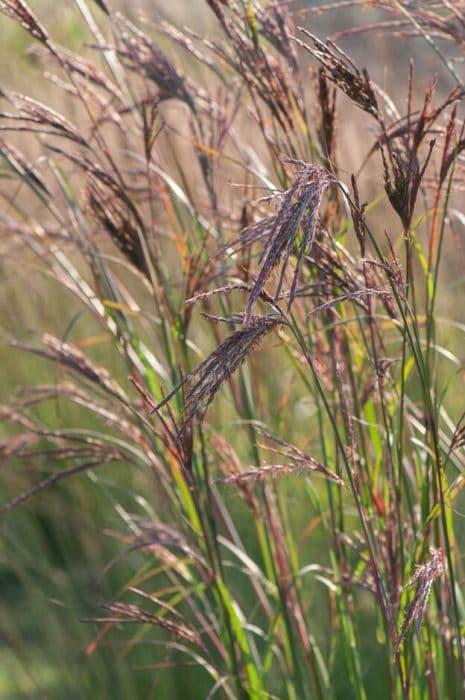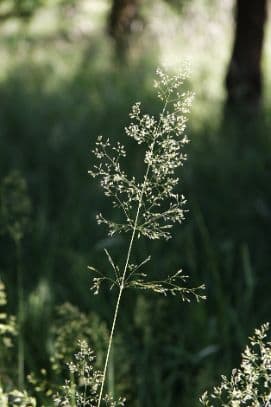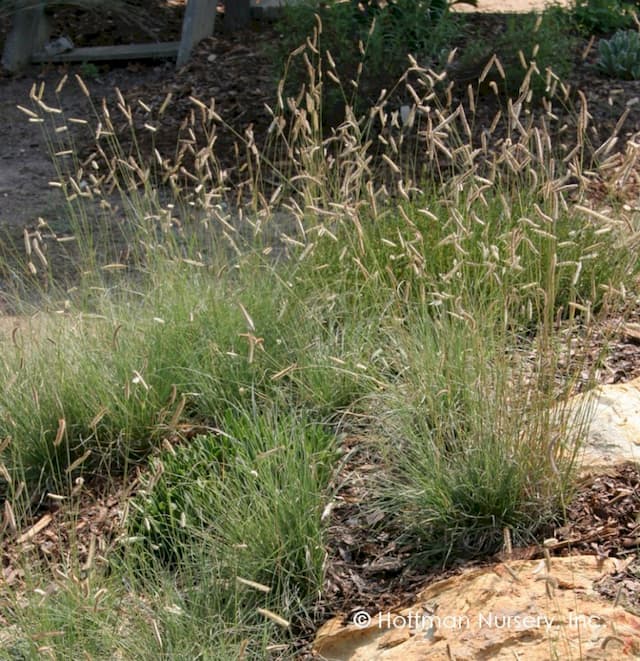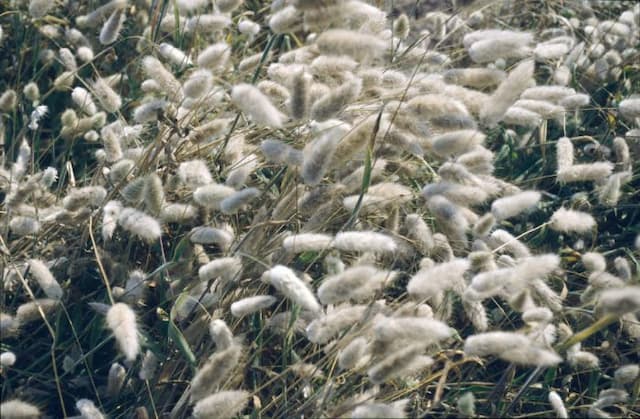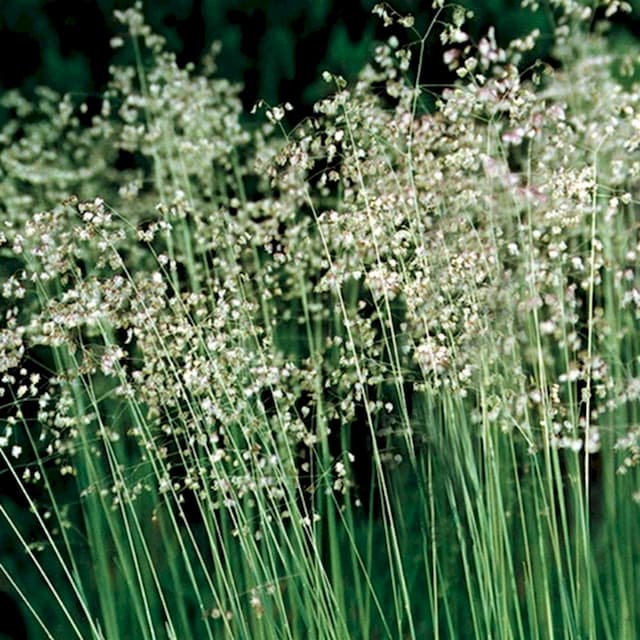Feather Reed Grass Calamagrostis × acutiflora 'Overdam' (v)

ABOUT
Calamagrostis × acutiflora 'Overdam', commonly known as variegated feather reed grass, is a striking ornamental grass distinguished by its attractive foliage and showy flower plumes. The leaves of this perennial are long and narrow, featuring a bright green color with creamy white edges, giving it a variegated appearance. The texture of the leaves is fine, creating a graceful and soft look in the garden. During the growing season, variegated feather reed grass produces tall, feathery flower plumes that can add a sense of verticality and movement. These flowers start with a purplish tinge and mature to a golden tan color, persisting through the fall and even into the winter months, providing long-lasting visual interest. The overall form of the plant is upright and clump-forming, making it an excellent choice for creating structure in a garden design.
About this plant
 Names
NamesFamily
Poaceae
Synonyms
Feather Reed Grass, Variegated Feather Reed Grass, Overdam Feather Reed Grass
Common names
Calamagrostis × acutiflora 'Overdam'
 Toxicity
ToxicityTo humans
Feather reed grass, which is the common name for Calamagrostis × acutiflora 'Overdam', is not known to be toxic to humans. Therefore, it is unlikely to cause poisoning if ingested. However, as with any plant, individual allergies or sensitivities may occur.
To pets
Feather reed grass, the common name for Calamagrostis × acutiflora 'Overdam', is not recognized as a toxic plant to pets. It should not cause poisoning in animals if they happen to ingest it. That said, pets may have individual sensitivities, and ingestion of non-food items can sometimes result in gastrointestinal upset.
 Characteristics
CharacteristicsLife cycle
Perennials
Foliage type
Deciduous
Color of leaves
Variegated
Flower color
Purple
Height
4 feet (1.22 meters)
Spread
2 feet (0.61 meters)
Plant type
Grass
Hardiness zones
4
Native area
Europe
Benefits
 General Benefits
General Benefits- Ornamental Appeal: 'Overdam' adds visual interest to gardens with its variegated foliage and feathery, silvery inflorescences that emerge in summer.
- Low Maintenance: Once established, this grass requires minimal care, making it a convenient choice for gardeners of all skill levels.
- Drought Tolerance: It is relatively tolerant of dry conditions, reducing the need for frequent watering once it's well-established.
- Cold Hardy: It can withstand cold temperatures, making it suitable for cooler climates and a robust addition to many gardens.
- Erosion Control: The dense growth habit can help stabilize soil and control erosion on slopes or banks.
- Adaptable: 'Overdam' thrives in a variety of soil conditions, from clay to sandy loam, as long as the site is well-drained.
- Architectural Structure: Its upright form and contrasting foliage provide strong vertical lines in the garden landscape.
- Wildlife Support: Although not the primary attraction for wildlife, the seeds can provide food for birds in the winter months.
- Seasonal Interest: 'Overdam' offers visual interest throughout the growing season and even into winter when the grasses turn a golden-brown.
- Divisibility: It can be easily divided to propagate new plants and spread them throughout the garden or share with other gardeners.
- Design Versatility: Works well in a variety of garden styles including formal, naturalistic, and contemporary designs.
- Works as a Screen: Can be used to create a semi-transparent screen or hedge in the landscape without the need of a built structure.
 Medical Properties
Medical PropertiesThis plant is not used for medical purposes.
 Air-purifying Qualities
Air-purifying QualitiesThis plant is not specifically known for air purifying qualities.
 Other Uses
Other Uses- Feather Reed Grass stalks can be used for basket weaving due to their strength and flexibility.
- Dried stalks of Feather Reed Grass can be incorporated into natural craft projects, like homemade wreaths or as a detail in handcrafted picture frames.
- The plant can serve as a noise barrier when planted densely, muffling traffic or neighborhood sounds in urban gardens.
- Feather Reed Grass can be planted to prevent soil erosion on slopes thanks to its dense root structure that holds soil in place.
- This grass variety is used in xeriscaping designs to achieve attractive landscapes that require minimal supplemental watering.
- The tall grasses can be used as habitat enhancement for garden wildlife, offering shelter for small animals and insects.
- When left to stand over the winter, the dried flower heads can provide visual interest in the garden even during the colder months.
- Feather Reed Grass can be included in educational gardens to teach about plant life cycles and ornamental grass care.
- Photographers sometimes use this plant as a soft-focus background in portrait and macro photography due to its feathery texture.
- It can be used as a guideline or living fence in a garden to delineate different areas or pathways.
Interesting Facts
 Feng Shui
Feng ShuiThe plant Feather Reed Grass is not used in Feng Shui practice.
 Zodiac Sign Compitability
Zodiac Sign CompitabilityThe plant Feather Reed Grass is not used in astrology practice.
 Plant Symbolism
Plant Symbolism- Resilience: Feathertop grass, a common name for Calamagrostis × acutiflora 'Overdam', grows robustly and persists through various conditions, symbolizing the ability to endure and adapt.
- Growth: As a plant that can reach up to several feet in height, it represents personal or spiritual growth and the pursuit of one's aspirations.
- Elegance: With its variegated foliage and graceful flower plumes, feathertop grass is often associated with sophistication and refined beauty.
- Privacy: When planted in dense clumps, feathertop grass can create natural screens, symbolizing a barrier or retreat from the outside world.
- Transition: The changing colors of the grass throughout the seasons reflect the passage of time and life's changing nature.
 Water
WaterFeather Reed Grass should be watered deeply but infrequently to encourage a robust root system. During the growing season, water the plant when the top inch of soil feels dry, which typically means once every week or two, depending on the weather conditions. Apply water at the base of the plant, avoiding wetting the foliage, to reduce the risk of disease. Each watering session should provide enough water to moisten the soil to a depth of 6 inches. An established Feather Reed Grass may need approximately 1 to 1.5 gallons of water per week during hot and dry periods.
 Light
LightFeather Reed Grass thrives best in full sun to partial shade. It should be placed in an area where it can receive at least six hours of sunlight per day for optimal growth and development. While the plant can tolerate some shade, too little light can lead to weak, floppy growth.
 Temperature
TemperatureFeather Reed Grass is adaptable to a wide range of temperatures and can survive in conditions as low as -20°F and as high as 90°F. For optimal growth, Feather Reed Grass prefers to be in an environment where the temperature ranges between 60°F and 75°F. It is quite hardy and can tolerate winter cold well.
 Pruning
PruningFeather Reed Grass should be pruned to remove old foliage and make way for new growth. Cutting back the plant to about 4 inches above the ground should be done in late winter or early spring before new growth starts. This annual pruning keeps the plant tidy and encourages a fresh flush of leaves.
 Cleaning
CleaningAs needed
 Soil
SoilFeather Reed Grass prefers well-drained soil with a mix of loam, sand, and compost to provide nutrients. The ideal pH level for this grass is slightly acidic to neutral, around 5.8 to 7.2.
 Repotting
RepottingFeather Reed Grass, being a perennial grass, does not require frequent repotting. It should be divided and repotted every 2-3 years to maintain vigor and control its spread.
 Humidity & Misting
Humidity & MistingFeather Reed Grass is tolerant of a wide range of humidity levels and does not have any specific humidity requirements, making it suitable for various outdoor conditions.
 Suitable locations
Suitable locationsIndoor
Ensure bright light, occasional watering, and not too hot.
Outdoor
Full sun to partial shade, well-drained soil, and winter hardy.
Hardiness zone
4-9 USDA
 Life cycle
Life cycleThe 'Overdam' feather reed grass (Calamagrostis × acutiflora 'Overdam') starts its life cycle when seeds germinate in late spring or early summer, given adequate moisture and temperature. The young seedlings establish a root system and develop into tufted clumps of variegated foliage with green and white striped leaves. As the plant matures, it enters the vegetative stage, during which it will grow taller and produce more foliage, typically reaching its full size by mid-summer. Following the vegetative stage, the plant begins the reproductive phase, producing tall, feathery inflorescences by early to mid-summer which can last until the end of the growing season. These inflorescences turn to a golden-brown in fall and can provide visual interest through winter if not cut back. The life cycle of 'Overdam' completes as it undergoes dormancy during the cold winter months, with growth resuming the following spring from the same root system, making it a perennial grass.
 Propogation
PropogationPropogation time
Spring
Calamagrostis × acutiflora 'Overdam', also known as Feather Reed Grass 'Overdam', is commonly propagated through division. The best time to divide this ornamental grass is in the spring as new growth emerges. To propagate through division, carefully dig up an established clump and use a sharp spade or knife to separate the plant into smaller sections, ensuring that each division has a good root system and several shoots. Replant these divided sections at the same depth they were growing at originally, spacing them about 18 to 24 inches apart (45 to 60 centimeters) to accommodate future growth. Water the new transplants thoroughly to help establish them. This method is not only popular due to its simplicity but it also helps maintain the health and vigor of the plant by rejuvenating older clumps which may have become woody and less productive over time.
